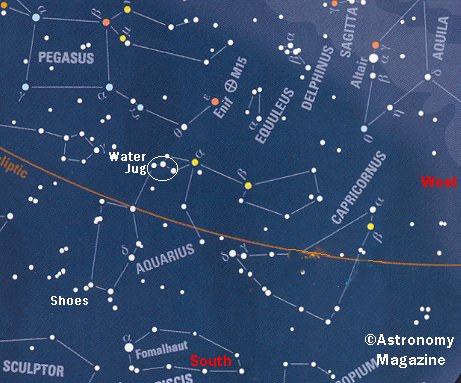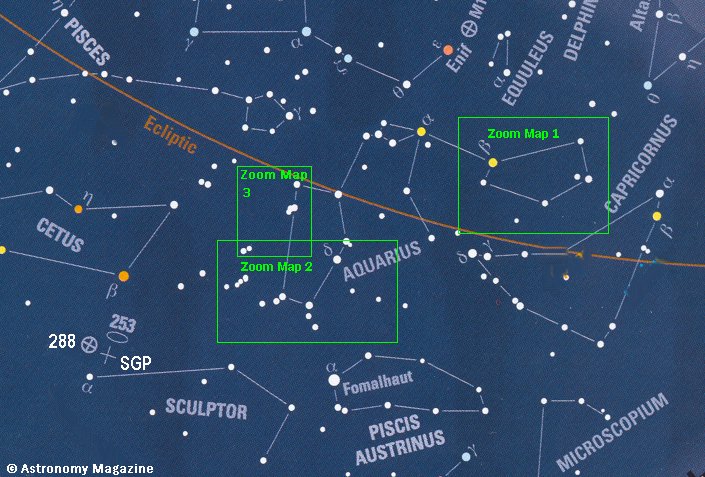Please check back in January for a NEW Constellation of the Month!
Constellation of the Month, November 2002
Aquarius
Click here to see the archive of past COTMs
 This month we delve
back into the realm of the Zodiac. A question that is often asked
by neophyte stargazers is "When can I see the constellation of my birth
sign?" Most people think that Zodiac signs are best seen in the months
that they represent. Actually, the opposite is true. During late January
and February, the sun is actually in the constellation of Aquarius;
therefore we are unable to see the background stars. The sun travels along
the Ecliptic, which on the above map is the solid orange line. The
answer to the above question, then, is that any given Zodiac sign is best
seen in the night sky 4 or 5 months before. This means that
Aquarius is best viewed in November, Pisces in December, and so on.
This month we delve
back into the realm of the Zodiac. A question that is often asked
by neophyte stargazers is "When can I see the constellation of my birth
sign?" Most people think that Zodiac signs are best seen in the months
that they represent. Actually, the opposite is true. During late January
and February, the sun is actually in the constellation of Aquarius;
therefore we are unable to see the background stars. The sun travels along
the Ecliptic, which on the above map is the solid orange line. The
answer to the above question, then, is that any given Zodiac sign is best
seen in the night sky 4 or 5 months before. This means that
Aquarius is best viewed in November, Pisces in December, and so on.
Aquarius is made up of fairly dim stars, so it can be hard to find.
Here's a tip: Face south and use the bright star Fomalhaut (bottom
left of the map). This star stands out as the only bright star in this
part of the sky, low to the horizon. Then look up (way up), nearly overhead,
and find the Square of Pegasus. The bulk of Aquarius, one of the
largest constellations, lies between Fomalhaut and the Great Square Also,
see if you can find the 3 stars of the Water Jug.
The figure of Aquarius the Water Bearer is supposed to represent a person
bending over, pouring a bucket of water. Considering that the constellation
under (or south) of Aquarius is Piscis Austrinus (the southern fish),
this is quite appropriate! In the above map, the person seems to have an
enormous head, and a long neck between the stars a
and b. In one arm is the Water
Jug, and the legs go down towards Fomalhaut. Finally, we come to a
very interesting asterism which I have nicknamed "The Shoes". There
are actually 3 of them (the third is to the left). The shoes are 3 groups
of 3 stars remarkably similar in brightness. But they are faint, and you
probably won't be able to see the Shoes unless you have dark skies and
a clear horizon.

Aquarius is such a large, sprawling constellation that I have created
3 Zoom Maps to illustrate where the interesting objects are. The
approximate regions of each map are shown above. Also, pay special attention
to 253 and 288. These numbers are NGC
catalog designations. 253 is a spectacular edge-on galaxy, and 288
is a faint globular cluster. It will take a moderate size telescope to
see these objects. Unfortunately there are no bright stars near these objects,
so the best way to find them is to use the star a
Sculptoris, and hop approximately 3 degrees north to 288. 253 is another
couple degrees to the northwest. More info about NGC
253 and NGC 288.
Also see our Image
of this area.
Zoom Map 1
Zoom Map 2
Zoom Map 3
The "SGP" in the above image stands for South Galactic Pole.
The cross marks the point in the sky that is 90 degrees from the Galactic
Equator, which runs through the constellations Cassiopeia, Cygnus,
and Sagittarius among others. The region around the SGP is star
poor, and allows us to look out of our own galaxy and see others, like
NGC 253.
Back to Night Sky Observers main page
 This month we delve
back into the realm of the Zodiac. A question that is often asked
by neophyte stargazers is "When can I see the constellation of my birth
sign?" Most people think that Zodiac signs are best seen in the months
that they represent. Actually, the opposite is true. During late January
and February, the sun is actually in the constellation of Aquarius;
therefore we are unable to see the background stars. The sun travels along
the Ecliptic, which on the above map is the solid orange line. The
answer to the above question, then, is that any given Zodiac sign is best
seen in the night sky 4 or 5 months before. This means that
Aquarius is best viewed in November, Pisces in December, and so on.
This month we delve
back into the realm of the Zodiac. A question that is often asked
by neophyte stargazers is "When can I see the constellation of my birth
sign?" Most people think that Zodiac signs are best seen in the months
that they represent. Actually, the opposite is true. During late January
and February, the sun is actually in the constellation of Aquarius;
therefore we are unable to see the background stars. The sun travels along
the Ecliptic, which on the above map is the solid orange line. The
answer to the above question, then, is that any given Zodiac sign is best
seen in the night sky 4 or 5 months before. This means that
Aquarius is best viewed in November, Pisces in December, and so on.
